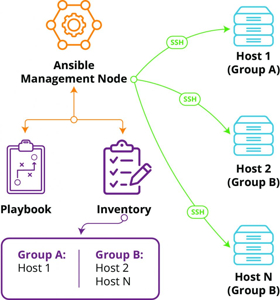Ansible is an open-source IT automation tool that helps you configure systems, deploy applications, and automate IT tasks such as provisioning, configuration management, application deployment, orchestration, and continuous delivery.
Key Points about Ansible:
- Agentless: Ansible does not require any agent software on managed nodes; it uses standard SSH (for Linux) or WinRM (for Windows) to communicate.
- Simple and Human-Readable: Uses YAML for writing automation scripts, called playbooks, making it easy to learn and read.
- Idempotent: Ensures that running a playbook multiple times always produces the same result, preventing unintended changes.
- Scalable: Can manage a few servers or thousands, scaling from small environments to enterprise-level.
- Extensible: Supports modules, plugins, roles, and collections to extend its functionality.
Typical Use Cases:
- Installing and configuring software on multiple servers.
- Managing cloud infrastructure (AWS, Azure, GCP, etc.).
- Orchestrating application deployments and rolling updates.
- Enforcing consistent configuration and security policies.
Example:
Suppose you want to install Apache on 50 servers. With Ansible, you’d write a playbook in YAML, and Ansible would handle connecting to each server, installing Apache, and ensuring it’s configured the same way everywhere—automatically.

Ansible is an open-source IT automation tool designed to simplify tasks such as configuration management, software provisioning, application deployment, and orchestration across both on-premises and cloud environments. Written in Python, Ansible enables users to define the desired state of their infrastructure using easy-to-read YAML files known as playbooks, making complex operations reproducible and understandable even for those with limited programming experience.
Key Features of Ansible
- Agentless: Ansible does not require any software (agents) to be installed on the managed systems. Instead, it connects over SSH (or Windows Remote Management) from a central control node, executes tasks, and then cleans up after itself.
- Infrastructure as Code (IaC): With Ansible, infrastructure configuration is codified and version-controlled, supporting best practices and auditability.
- Modules and Tasks: Ansible uses modules (small programs) to perform actions on target nodes. These modules are invoked via tasks within playbooks to enforce the desired state.
- Idempotence: Ansible modules are generally idempotent—they only make changes if the system’s state does not match the desired state—and do nothing if it already matches.
- Cross-platform: Ansible supports managing a wide range of operating systems, including Linux, Windows, network devices, and cloud platforms.
What Can Ansible Automate?
- Provisioning: Set up servers, cloud infrastructure, and containers.
- Configuration Management: Manage software installations, updates, service states, firewall configurations, and user accounts.
- Application Deployment: Automate application delivery, updates, and rollbacks.
- Orchestration: Coordinate complex workflows across multiple hosts and applications, ensuring dependencies are handled in the correct order.
- Compliance and Security: Enforce configuration policies and remediate drift automatically.
Why Use Ansible?
- Simple syntax: Uses YAML, which is readable by both humans and machines.
- No agents: Easy to maintain and secure, reducing operational overhead.
- Extensible: Supports thousands of modules and integrates with major IT systems and platforms.
- Strong community: Backed by Red Hat and a large open-source community, with extensive documentation and resources.
In summary:
Ansible is widely regarded for its ease of use, flexibility, and ability to help IT teams automate repetitive tasks, ensure consistency, and efficiently manage large-scale infrastructure with minimal effort.
In short:
Ansible is a powerful tool for automating and standardizing IT operations, saving time, reducing errors, and making complex infrastructure easy to manage.